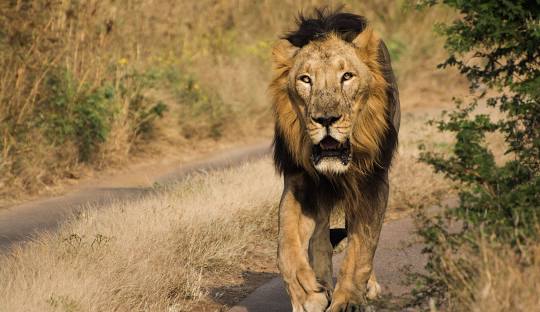Table of Contents
Gir National Park, also known as Sasan Gir, is a critical sanctuary for wildlife enthusiasts. Situated in Gujarat, this park is renowned for being the last refuge of the Asiatic lion. Established in 1965, Gir National Park has played a significant role in wildlife conservation in India. This comprehensive guide will delve into the park’s location, wildlife, conservation efforts, and significance for UPSC and State PSC notes.
Location
- Situated halfway between Veraval and Junagadh in Gujarat, India.
- Encompasses a 1412 sq.km sanctuary, including a 259-sq-km core area declared as a national park in 1975.
- Located 43 km north-east of Somnath, 65 km south-east of Junagadh, and 60 km south-west of Amreli.
Historical Background
- Established in 1965 in the erstwhile Nawab of Junagarh’s private hunting area.
- Initially covering a total area of 1,410.30 km2, now protected as both a national park and wildlife sanctuary.
- Part of the Khathiar-Gir dry deciduous forests ecoregion.
Wildlife in Gir National Park

- Last refuge of the Asiatic lion (Panthera leo persica).
- Home to 37 other mammal species, including:
- Chital (spotted deer)
- Sambar (large deer)
- Nilgai (blue bull/large antelopes)
- Chousingha (four-horned antelopes)
- Chinkara (gazelles)
- Crocodiles
- Rarely seen leopards
- A haven for bird watchers with over 300 bird species, mostly residents.
Devalia Safari Park
- Alternative for lion encounters if permits for Gir are unavailable.
- A 4.12-sq-km fenced-off area within the sanctuary where sightings are guaranteed.
- Offers 45-minute bus tours with chances to see lions, leopards, foxes, mongoose, and blackbuck.
Human Community
- Historically inhabited by the Maldhari (herders) community.
- Many resettled due to competition for food resources and predation by lions and leopards.
- About 1000 people still live in the park, with their livestock making up a quarter of the lions’ diet.
Lion Population 2020
- According to the 2020 lion census in India, the population of Asiatic lions in the Gir forest region was estimated to be 674.
- The 2015 census recorded 523 lions, a 27% increase from 2010.
- Numbers have increased from less than 200 in the late 1960s to 674 in the 2020 census.
- Distribution in 2015 included:
- 268 in Junagadh District
- 44 in Gir Somnath District
- 174 in Amreli District
- 37 in Bhavnagar District
- Population included 109 males, 201 females, and 213 cubs.
- The park is closed annually from June 16 to October 15 during the monsoon season.
List of National Parks in India

Read More
List of National Parks in India
Explore the comprehensive list of 106 National Parks in India. Essential general knowledge for UPSC and State PSC exam preparation. Learn about India’s diverse wildlife and protected areas.
Gir National Park offers a unique and enriching experience for wildlife enthusiasts, bird watchers, and nature lovers. Its successful conservation efforts have made it a sanctuary for the majestic Asiatic lion and a diverse array of other wildlife species.
